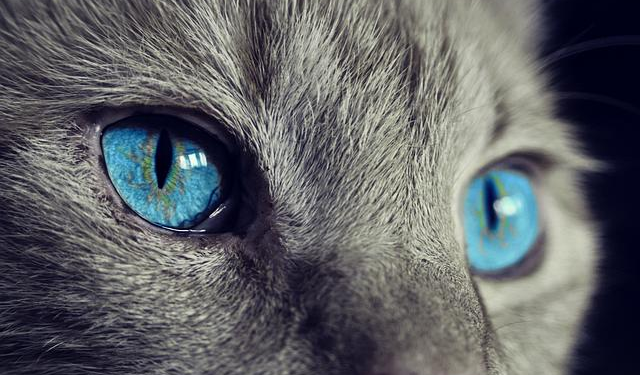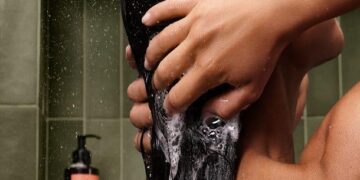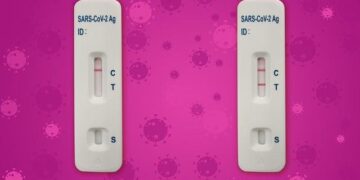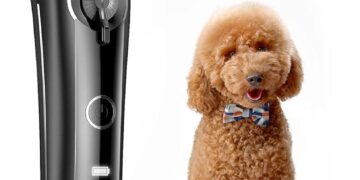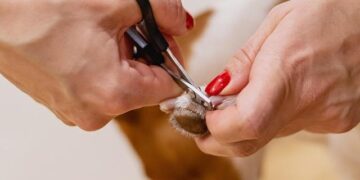Table of Contents
My Bernese Mountain Dog, Leo, is a walking paradox of majestic fluff and pure, unadulterated chaos.
His coat is a masterpiece—a thick, tri-color tapestry that feels like a cloud and sheds like a snowstorm.1
For years, keeping that masterpiece clean felt like a Herculean task.
The full-blown bath was an event, a splash zone of epic proportions that left both of us, and the entire bathroom, soaked and exhausted.
So, like many loving, busy dog owners, I went searching for a shortcut.
The aisle of dry and waterless dog shampoos seemed like a miracle.
Bottles promised a “quick and easy deep clean,” a “fresh scent,” and a happy, clean dog without the drama of the tub.1
I bought into the promise completely.
As a professional in veterinary product formulation, I recognized brands, trusted labels that screamed “natural” and “hypoallergenic,” and felt confident I was making a smart choice.1
At first, it seemed to work.
A few spritzes of a lavender-scented foam before guests arrived, and Leo smelled heavenly.1
But a day or two later, the scratching would start.
A subtle itch at first, then a frantic, full-body obsession.
He’d gnaw at his paws, rub his face on the carpet, and leave a fine dusting of white flakes—dandruff—on our dark hardwood floors.5
We’d visit the vet, discussing potential food or environmental allergies, running tests, and trying different diets, but the cycle continued.7
Temporary freshness, followed by days of misery.
The breaking point came after one particularly bad episode.
I had used a new, highly-rated foaming shampoo to clean up a muddy spot on his flank.
He was pristine for about 24 hours.
Then, for the next three days, he was inconsolable.
I’d watch him, whimpering as he scratched, and a wave of guilt washed over me.
My attempt to solve a simple problem—a little bit of dirt—had caused him real, prolonged suffering.
I, a person who literally helps develop safe products for animals, was making my own dog sick.
That night, I didn’t sleep.
I gathered every bottle of waterless shampoo I owned and spread them across my kitchen counter.
My professional frustration finally boiled over.
I stopped reading the marketing on the front and started analyzing the ingredient lists on the back, cross-referencing every chemical with dermatological studies and toxicology reports I had access to through my work.
And that’s when the epiphany hit me.
It was a realization so profound it changed everything about how I care for Leo.
I had been treating his skin like an inert surface, a piece of carpet to be spot-cleaned and deodorized.
But the science was screaming at me that I was wrong.
A dog’s skin isn’t a carpet.
It’s a living, breathing ecosystem.
It’s a garden.
And I had been spraying my beautiful, delicate garden with a cocktail of chemical weed killers and acid rain, then wondering why my plants were dying.
This shift in perspective—from janitor to gardener—didn’t just give me an answer; it gave me a whole new framework for understanding canine health.
It’s a framework that threw out the quick fixes and replaced them with a patient, nurturing approach that finally gave Leo relief and brought his coat back to a state of true, vibrant health.
The Epiphany: Your Dog’s Skin Isn’t a Carpet, It’s a Living Garden
The “quick fix” mindset is seductive.
We see a problem—odor, dirt—and we want a product that makes it disappear.
This is the janitorial approach: see a mess, sterilize it, deodorize it.
This approach works for kitchen counters and bathroom floors.
It is a disaster for living tissue.
The “Skin as a Garden” analogy reframes the entire goal of grooming.
A gardener doesn’t seek to sterilize their soil; they seek to cultivate a balanced, thriving ecosystem where healthy plants can flourish and naturally crowd out weeds and pests.
The goal is not a sterile environment, but a resilient one.
When you apply this model to your dog’s skin and coat, the flaws of products like dry shampoo become glaringly obvious.
This framework is built on five core pillars, each representing a crucial aspect of your dog’s living “skin garden”:
- The Soil: The Skin’s Physical Structure & pH Balance. This is the foundation. Healthy soil has the right composition and chemical balance (pH) to support life. If the soil is too acidic or too alkaline, nothing can grow properly. A dog’s skin, the literal foundation of their coat, has a unique pH that is essential for its health.
- The Ecosystem: The Skin Microbiome. A healthy garden is teeming with invisible life—beneficial bacteria, fungi, and microbes that create a complex, protective web in the soil. This is the microbiome. Your dog’s skin has its own version of this, a vast community of microorganisms that acts as a living shield against disease, allergens, and infection.9
- The Weeds & Pests: Harmful Ingredients. These are the disruptive elements we introduce into the garden. In grooming products, these are the harsh chemicals, detergents, and allergens that damage the soil, kill the beneficial ecosystem, and create an environment where problems can thrive.
- The Nutrients & Fertilizers: Beneficial Ingredients. These are the elements that nourish and support the garden. In grooming, these are ingredients and techniques that respect the skin’s pH, feed the microbiome, and bolster the skin’s natural defenses.
- The Gardener’s Touch: Grooming Techniques. This is how we physically interact with the garden. Are we gently tilling the soil and pruning the plants, or are we blasting everything with a pressure washer? Our methods matter just as much as the products we use.
Using this framework, I began to see that every time I reached for a bottle of dry shampoo, I wasn’t tending to Leo’s garden.
I was launching an all-out chemical assault on it.
A Critical Look at the Dry Shampoo Aisle: Tending the Garden with Care
Armed with the “Skin as a Garden” paradigm, my trips down the pet care aisle became an exercise in forensic analysis.
I was no longer looking for the best scent or the most convincing marketing claim; I was evaluating how each product would interact with the delicate biology of Leo’s skin.
The Soil: Why Your Dog’s Skin is Not Like Yours
The single most important lesson for any dog owner is this: you cannot use human products on your dog.
This isn’t a marketing gimmick to sell more products; it’s a fundamental biological reality rooted in pH balance.11
The pH scale, which runs from 0 (highly acidic) to 14 (highly alkaline), with 7 being neutral, is a measure of acidity.
Your skin and your dog’s skin exist on different ends of this spectrum.
Human skin is acidic, with a pH balance typically between 4.5 and 5.6.12
This acidic environment creates a protective barrier called the “acid mantle,” which fends off harmful bacteria and viruses.
Human shampoos are formulated to match this acidic pH.
Dog skin, however, is much more neutral to alkaline, with a pH balance ranging from 6.2 to 7.5, and in some cases even higher.12
Using a human shampoo on a dog is the chemical equivalent of pouring acid rain on a garden that requires neutral soil.
The acidic formula strips away their protective mantle, leaving the skin vulnerable, irritated, and dry.11
This disruption is a direct invitation for parasites, yeast, and bacteria to set up shop, leading to the exact kind of itching and flaking I was seeing in Leo.
To make matters worse, a dog’s skin is significantly thinner than ours.
While we have 10-15 layers of skin cells, dogs have only 3-5.12
This makes their “soil” far more delicate and susceptible to damage from improperly formulated products.
Even a product marketed for dogs can be problematic if it doesn’t respect this crucial pH balance, and since dry shampoos are “leave-on” products, that chemical assault is prolonged for hours or even days.
The Ecosystem: The Invisible Guardians of Your Dog’s Health
For decades, we’ve been taught that “clean” means sterile—the absence of all bacteria.
Modern science has shown this to be a dangerously outdated concept.
A healthy body, whether human or canine, is not sterile; it is a thriving ecosystem.
The skin microbiome is a complex community of trillions of beneficial bacteria, fungi, and other microorganisms that live on the skin’s surface.10
This invisible shield is the garden’s first line of defense.
It helps regulate inflammation, maintains hydration, and actively fights off pathogenic invaders by out-competing them for resources.9
Many grooming products, especially those designed to “deodorize” and “disinfect,” function like broad-spectrum pesticides in a garden.
They contain preservatives, detergents, and antibacterial agents that don’t distinguish between the good bugs and the bad bugs.9
When you apply a foaming or spray-on dry shampoo, you are often wiping out this protective ecosystem.
This explains the vicious cycle Leo was trapped in.
The product would temporarily mask odors, but in doing so, it would destroy his skin’s natural defenses.
With his microbiome compromised, opportunistic yeast and bacteria could proliferate unchecked, leading to inflammation, odor, and the intense itching that followed a day or two later.
I wasn’t cleaning him; I was making his skin’s ecosystem unstable, creating the very problems I was trying to solve.
Analyzing the Tools: Deconstructing Foams, Sprays, and Powders
Not all dry shampoos are created equal, but when viewed through the “gardening” lens, their fundamental flaws become clear.
They fall into three main categories, each with its own method of disrupting the skin’s delicate balance.
Powders (The Suffocating Mulch):
Powder-based dry shampoos are the oldest form, typically using absorbent materials like cornstarch, baking soda, arrowroot powder, or kaolin clay to soak up excess oil and moisture.19 On the surface, these ingredients can seem benign and “natural.” Some people even make DIY versions at home.19
The problem is that these powders don’t actually clean anything.
They don’t remove dirt, dander, or allergens; they simply mix with them, creating a gritty, oil-laden paste that clings to the skin and fur.20
While a light dusting might temporarily reduce odor, overuse acts like a layer of suffocating mulch.
It can clog pores and hair follicles, trapping bacteria and preventing the skin from breathing.20
This can lead to stunted hair growth, skin irritation, and a dull, heavy coat.
Brushing the powder out is essential, but it’s nearly impossible to remove it all, especially from a thick-coated dog like Leo.
The remaining residue becomes a source of mechanical irritation, literally grinding against the skin with every movement.
Foams & Sprays (The Chemical Surfactants):
These are the most common types of waterless shampoos.
They are not “dry” in the sense of being a powder; the term “dry” simply means no rinsing is required.24 These products are liquids that use chemical surfactants (cleansing agents) to break down and bind to dirt and oil, allowing them to be theoretically wiped away with a towel.21
This is where the most significant danger lies.
Foams and sprays are the quintessential “leave-on” products.21
Unlike a traditional bath where shampoo is on the skin for minutes before being thoroughly rinsed away, the chemical cocktail in a waterless shampoo remains in direct, prolonged contact with the skin and fur.24
This maximizes the potential for irritation, allergic reactions, and absorption of harmful chemicals into the body.18
Furthermore, many of these products contain alcohols that evaporate to give a “quick-dry” feeling but can be intensely drying to the skin, further disrupting the “soil”.25
Aerosol sprays can be even more problematic, as they often use petroleum distillate propellants like propane or butane.
These propellants can be contaminated with benzene, a known carcinogen, which can be inhaled by both you and your dog during application.24
The “Weed Killer” Ingredient Watchlist
Reading an ingredient label can feel like deciphering an ancient text.
Marketers use this confusion to their advantage, highlighting a single “natural” ingredient like oatmeal or aloe vera while burying a list of harsh synthetic chemicals in the fine print—a practice known as “greenwashing”.20
As a gardener, you must learn to identify the weeds.
The following table lists some of the most common and problematic “weed killer” ingredients found in dog grooming products.
| Ingredient Name | Common On Labels As | Function in Product | Potential Harm to the “Skin Garden” |
| Sulfates | Sodium Lauryl Sulfate (SLS), Sodium Laureth Sulfate (SLES), Ammonium Lauryl Ether Sulfate | Harsh Detergent, Foaming Agent | The Chemical Salt-Wash: Aggressively strips the “topsoil” (natural oils), decimates the entire microbiome (good and bad microbes), and leaves the skin dry, irritated, and defenseless.18 |
| Parabens | Methylparaben, Propylparaben, Butylparaben, Ethylparaben | Preservative | The Hormone Disruptor: Absorbed through the skin, these chemicals can interfere with the body’s endocrine system, potentially causing long-term health issues.20 |
| Artificial Fragrances | Fragrance, Parfum | Scent | The Hidden Allergen Swarm: A vague term that can legally hide hundreds of undisclosed chemicals, many of which are potent allergens and common triggers for skin inflammation, itching, and respiratory issues.20 |
| Formaldehyde Releasers | DMDM Hydantoin, Imidazolidinyl Urea, Diazolidinyl Urea, Quaternium-15 | Preservative | The Slow-Acting Poison: These chemicals work by slowly releasing formaldehyde, a known carcinogen, to kill microbes. This exposes your dog to a constant low dose of a toxic substance linked to cancer, skin irritation, and nervous system damage.20 |
| Phthalates | Often hidden under “Fragrance” | Fragrance Stabilizer, Plasticizer | The Invisible Toxin: Another endocrine disruptor often used to make scents last longer. Linked to hormonal issues and potential damage to the liver and kidneys.26 |
| Harsh Alcohols | Isopropyl Alcohol, Ethanol | Solvent, Drying Agent | The Chemical Drought: While some fatty alcohols can be beneficial, simple alcohols like these are extremely drying. They strip moisture from the skin, causing irritation and compromising the skin’s protective barrier.25 |
| Mineral Oil | Mineral Oil, Paraffinum Liquidum | Moisturizing Agent | The Plastic Wrap: A petroleum byproduct that creates an occlusive barrier on the skin. While it can trap moisture, it can also clog pores, trap bacteria, and prevent the skin from breathing naturally.18 |
| Artificial Colors | FD&C Blue #1, etc. | Colorant | The Synthetic Dye: Derived from petroleum, these dyes serve no therapeutic purpose and are linked to allergic reactions, skin irritation, and potential carcinogenic properties.20 |
This list became my guide.
I started scanning labels with the critical eye of a gardener protecting their plot, and I was horrified.
Nearly every “quick-fix” product on my counter contained at least one, and often several, of these chemical weed killers.
My convenience was costing Leo his comfort and health.
It was time to throw out the old tools and find a better way to garden.
The Regenerative Approach: Cultivating a Thriving Coat
Abandoning the dry shampoo aisle felt like a liberation.
It forced me to stop looking for a product to solve my problem and start looking for a process.
A regenerative gardener focuses on building healthy soil, knowing that healthy soil will naturally produce healthy plants.
I applied the same logic to Leo.
My new goal was to support his skin’s natural ability to stay clean and healthy.
This meant embracing simpler, more effective tools and techniques.
The Gardener’s Most Important Tool: The Brush
The single most powerful, beneficial, and underrated tool in any dog owner’s grooming arsenal is the brush.
Regular, thorough brushing is the cornerstone of a healthy coat, and it achieves far more than any dry shampoo ever could, without a single drop of chemicals.
First, it is the ultimate form of mechanical cleaning.
A good brush physically removes loose hair, dander (dead skin cells), dirt, dust, and environmental allergens like pollen from the coat before they have a chance to build up and cause irritation.31
This is like gently tilling and weeding the garden, keeping it free of debris.
Second, and most importantly, brushing is the best way to distribute your dog’s natural sebum oils.
These oils are produced by glands in the skin and are the perfect, custom-made, pH-balanced conditioner for your dog’s specific coat.11
When a dog’s coat looks dull or feels dry, it’s often because these oils are trapped at the skin’s surface.
Brushing draws these oils down the hair shaft, waterproofing the fur, creating a natural shine, and moisturizing the skin.
It’s the ultimate regenerative technique—using the garden’s own resources to nourish itself.
For Leo, a 10-minute daily brushing session did more for his coat’s health and appearance than any product I had ever bought.
Healthier Alternatives for Spot-Cleaning and Freshening Up
Of course, life with a dog is messy.
Muddy paws, food-crusted beards, and the occasional roll in something unmentionable are inevitable.
While a full bath is the only true way to get a dog clean, I discovered a new class of products designed to work with the skin’s biology for those in-between moments.
These are the tools of the modern, science-informed gardener.
The Gentle Rain: Micellar Water Cleansers
You may have seen micellar water in human skincare, and the technology is now being applied brilliantly to pet grooming.
Micellar water is not soap.
It’s a solution containing tiny cleansing molecules called micelles.
These micelles act like microscopic magnets, attracting and encapsulating dirt, oil, and debris without disrupting the skin’s delicate barrier.32
It is the epitome of gentle, targeted cleaning.
Instead of fire-hosing the whole garden with detergent, it’s like using a soft, damp cloth to wipe a single leaf.
I found it to be a game-changer for sensitive areas.
A bit of dog-specific, pH-balanced micellar water on a cotton pad is perfect for gently wiping away tear stains, cleaning food from around Leo’s muzzle, and tidying up the wrinkles and folds on certain breeds where bacteria can accumulate.33
It cleans effectively without stripping oils or leaving a harsh residue.
Seeding the Soil: Topical Probiotic Sprays
This is perhaps the most exciting frontier in pet dermatology.
If harsh chemicals act like pesticides that wipe out the skin’s microbiome, probiotic grooming products act like a high-quality compost tea, actively supporting it.
These products contain live, beneficial bacteria (probiotics) and the nutrients they need to thrive (prebiotics).17
Instead of trying to kill the “bad” bacteria that cause odor, you are “seeding” the skin with “good” bacteria.
These beneficial microbes help to restore balance to the skin’s ecosystem, strengthen its natural defensive barrier, reduce inflammation, and out-compete the yeast and other microorganisms responsible for issues like “Frito feet” and general doggy odor.36
I started using a probiotic spray on Leo a few times a week, especially on his paws and belly.
It wasn’t a deodorizer in the traditional sense; it didn’t mask smells with fragrance.
Instead, it helped cultivate a healthier skin environment where those bad odors didn’t have a chance to develop in the first place.
The Simple Wipe-Down: High-Quality Grooming Wipes
For the quickest clean-ups, like wiping muddy paws at the door, grooming wipes are incredibly convenient.
However, not all wipes are created equal.
Many are saturated with the same problematic fragrances and preservatives found in sprays.
The key is to choose wipes that are as simple as possible: thick, durable, and moistened with a gentle, hypoallergenic formula that is free of alcohol and artificial scents.31 Look for soothing ingredients like aloe vera.
These are the equivalent of a quick, gentle rinse for a muddy garden tool—effective for surface dirt without disturbing the underlying soil.
DIY Options (Used with Extreme Caution)
For those who prefer a homemade approach, a heavily diluted apple cider vinegar (ACV) rinse can be beneficial in certain situations.
A solution of one part ACV to at least three parts water can help restore the skin’s pH balance and has mild antibacterial properties.39 However, this should
never be used on broken or irritated skin, as the acidity will sting and cause further inflammation.38
It is a tool to be used with knowledge and care, not as a universal cure-all.
This shift in my toolkit was revolutionary.
I was no longer fighting against Leo’s biology with harsh chemicals.
I was supporting it, nurturing it, and giving his skin what it needed to thrive on its own.
The results were undeniable.
The Harvest: A Vetted Toolkit for the Modern Dog Owner
The transformation in Leo was profound.
Within a month of throwing out the dry shampoos and adopting my “gardening” approach, the frantic scratching stopped.
The constant licking of his paws ceased.
The white flakes vanished from his dark fur, replaced by a deep, lustrous shine that came from health, not from a silicone-based product.
He smelled clean—not like artificial lavender or cucumber, but like a healthy, happy dog.
Our daily grooming sessions, once a source of stress, became a quiet ritual of bonding and care.
His garden was finally thriving.
This journey taught me that the best way to care for our dogs is to understand and respect their biology.
The “quick fix” is often a trap that creates more problems than it solves.
True health comes from cultivating a balanced ecosystem.
The Gardener’s Action Plan: A Quick-Reference Summary
To help you start tending your own dog’s skin garden, here are the core principles of this regenerative approach:
- Think Like a Gardener, Not a Janitor: Your goal is to cultivate a healthy, resilient skin ecosystem, not to sterilize an inert surface.
- The Brush is Your Best Friend: Daily brushing is the single most effective way to remove debris, distribute natural oils, and keep the coat healthy without chemicals.
- Read the Ingredient Label, Not the Marketing Label: Become a student of ingredients. Learn to spot the “weeds” (harsh chemicals) and choose products with clean, simple, and beneficial formulas.
- Respect the pH: Never use human shampoo on your dog. Always choose grooming products specifically formulated for the neutral-to-alkaline pH of canine skin.
- Nurture the Microbiome: Avoid products with harsh detergents and broad-spectrum preservatives that destroy the skin’s protective ecosystem. Actively support it with probiotic-friendly products.
- For Spot-Cleans, Choose Biology Over Harsh Chemistry: For in-between bath clean-ups, opt for gentle, modern solutions like micellar water and probiotic sprays that work with your dog’s skin, not against it.
My Curated Toolkit: Product Recommendations Aligned with the Gardening Philosophy
This is not a list of the “best dry shampoos.” As I hope this journey has made clear, I believe the very concept is flawed.
Instead, this is a curated toolkit of products that align with the “Skin as a Garden” philosophy.
These are the types of tools I now use for Leo to keep his skin and coat healthy and vibrant between his (still infrequent) full baths.
| Tool Category | Product Example & Brand | Key Features | Primary Use Case | “Why It Works for the Garden” |
| Mechanical Tools (Tilling & Weeding) | Chris Christensen Big G Slicker Brush; FURminator Undercoat deShedding Tool | High-quality pins, ergonomic handle, effective design | Daily brushing, removing loose undercoat and debris | Tills the Soil: Physically removes dead skin, dirt, and allergens without chemicals. Distributes the garden’s own natural “fertilizer” (sebum oils) to nourish the coat.31 |
| Gentle Cleansers (The Gentle Rain) | Douxo S3 CARE Micellar Solution; Hydra Luxury Care Micellar Water | pH-balanced, soap-free, no-rinse, hypoallergenic formula | Cleaning tear stains, dirty muzzles/beards, skin folds, and paws | Provides a Gentle Rain: Uses micelles to lift dirt and oil without stripping the skin’s protective barrier or disrupting the pH of the “soil.” It’s targeted cleaning for delicate areas.32 |
| Microbiome Support (Compost & Fertilizer) | Skout’s Honor Probiotic Deodorizer Spray; Earthbath Waterless Grooming Foam (Hypo-Allergenic) | Contains live probiotics or is formulated to be microbiome-friendly; free of harsh chemicals | All-over freshening, odor prevention, supporting skin health, soothing minor irritation | Adds Compost & Nutrients: “Seeds” the skin with beneficial microbes to strengthen its natural defenses, out-compete odor-causing “weeds,” and reduce inflammation. It actively cultivates a healthier ecosystem.36 |
| Emergency Spot-Clean (The ‘Least Harmful’ Option) | Chagrin Valley Soap & Salve Fresh Fur Dry Dog Shampoo (Powder) | Simple, organic ingredients: Arrowroot powder, cornstarch, kaolin clay, baking soda | EXTREMELY RARE USE for absorbing a specific oily or wet spot when no other option is available | A Dry Mulch (Use Sparingly): This is the least harmful version of a flawed tool. It absorbs oil without the harsh surfactants of foams/sprays. However, it can still clog pores and must be brushed out meticulously. It does not clean.20 |
A Final Word: A Partnership with Your Pet
My journey with Leo’s itchy skin began with a search for convenience and ended with a deeper understanding of my responsibility as his guardian.
Grooming is not a chore to be optimized and sped up with shortcuts.
It is an essential act of care, a daily opportunity to check in with our companions, to observe the health of their skin, to strengthen our bond, and to actively contribute to their overall well-being.
By trading the janitor’s mop for the gardener’s trowel, we can move beyond the endless cycle of masking symptoms and start cultivating true, foundational health.
Your dog’s vibrant, comfortable, and beautiful coat will be the harvest you reap from a garden tended with patience, knowledge, and love.
Works cited
- The 7 Best Dry Dog Shampoos for Stress-Free Bath Time – Rover.com, accessed August 15, 2025, https://www.rover.com/blog/dry-dog-shampoos/
- Dry Bath Shampoo for Dogs: A Complete Guide – Dogsee Chew, accessed August 15, 2025, https://www.dogseechew.in/blog/a-complete-guide-of-dry-bath-shampoo-for-dogs
- SOS hygiene for dogs and cats: why and how to cleanse with a dry shampoo – Dermoscent, accessed August 15, 2025, https://www.dermoscent.com/accueil/en/nos-conseils/sos-hygiene-for-dogs-and-cats-why-and-how-to-cleanse-with-a-dry-shampoo/
- Dry Shampoo For Dogs: When and How to Use it – Total.Vet, accessed August 15, 2025, https://total.vet/dry-shampoo-for-dogs/
- Can anyone recommend a good shampoo/conditioner for dry skin/dandruff for a dog’s coat?, accessed August 15, 2025, https://www.reddit.com/r/dogs/comments/s74v5x/can_anyone_recommend_a_good_shampooconditioner/
- [Help] Is the dog shampoo I’m using irritating my dog’s skin? – Reddit, accessed August 15, 2025, https://www.reddit.com/r/dogs/comments/82qi0i/help_is_the_dog_shampoo_im_using_irritating_my/
- Shampoo Allergies in Dogs – Symptoms, Causes, Diagnosis, Treatment, Recovery, Management, Cost – Wag!, accessed August 15, 2025, https://wagwalking.com/condition/shampoo-allergies
- Allergies and Skin Problems in Dogs | Animal Welfare Professionals – Maddie’s Pet Forum, accessed August 15, 2025, https://forum.maddiesfund.org/communities/community-home/digestviewer/viewthread?GroupId=205&MID=9287&CommunityKey=afce7f7a-fd5a-431e-9f2a-aaedc46a03d6&hlmlt=VT
- How Bathing Your Dog Affects Their Skin’s Microbiome – The Spaw, accessed August 15, 2025, https://www.ahhthespaw.com/how-bathing-your-dog-affects-their-skins-microbiome/
- Understanding Your Pet’s Skin Microbiome: What It Means for Their Health, accessed August 15, 2025, https://www.clairmontanimalhospital.com/blog/understanding-your-pets-skin-microbiome-what-it-means-for-their-health/
- Can I Use Human Shampoo on My Dog? Understanding the Basics of Dog Sha, accessed August 15, 2025, https://pawdawoflondon.com/blogs/pupdates/can-i-use-human-shampoo-on-my-dog-understanding-the-basics-of-dog-shampoo
- Can You Use Human Shampoo on Dogs?, accessed August 15, 2025, https://www.akc.org/expert-advice/health/human-shampoo-on-dogs/
- What Makes a Quality Dog Shampoo? – Earthbath, accessed August 15, 2025, https://earthbath.com/blogs/earthbath-blog/what-makes-a-quality-dog-shampoo
- Sensitive Dog Shampoo: Why pH Matters – Ruby Reese, accessed August 15, 2025, https://ruby-reese.com/blogs/the-science-behind-it/sensitive-dog-shampoo-why-ph-matters
- Shampooing dogs: facts and myths – Veterinary Practice, accessed August 15, 2025, https://www.veterinary-practice.com/article/shampooing-dogs-facts-and-myths
- pH balance in dog shampoo – numbers matter! – Rufus & Coco USA, accessed August 15, 2025, https://rufusandcoco.com/blogs/blog/ph-balanced-dog-shampoo
- The Ultimate Guide to Healthy Skin Microbiome for Dogs: Tips and Produ – Wag wonders, accessed August 15, 2025, https://wagwonders.in/blogs/grooming-and-microbiome-tips-for-pets/the-ultimate-guide-to-healthy-skin-microbiome-for-dogs-tips-and-products
- Unveiling the Reality: Chemical Ingredients in Skin and Coat Care Products for Dogs, accessed August 15, 2025, https://tauroproline.com/unveiling-the-reality-chemical-ingredients-in-skin-and-coat-care-products-for-dogs
- DIY Dry Shampoo for Dogs – The DINK Dog Mom, accessed August 15, 2025, https://thedinkdogmom.com/diy-doggy-dry-shampoo/
- Dry Shampoo For Dogs: Should You Use It?, accessed August 15, 2025, https://www.dogsnaturallymagazine.com/dry-shampoo-for-dogs/
- The Difference Between Dry Dog Shampoo and Waterless Dog Shampoo – 4-Legger, accessed August 15, 2025, https://www.4-legger.com/blogs/fetch-the-dog-blog/should-i-use-dry-dog-shampoo-on-my-dog
- How to Make Your Own Natural Dry Shampoo for Dogs – Crooked Chimney Farm, accessed August 15, 2025, https://crookedchimneyfarm.com/blogs/homesteading/how-to-make-your-own-natural-dry-shampoo-for-dogs
- Here’s the Correct Way to Use Dry Shampoo on Your Dog, According to a Vet, accessed August 15, 2025, https://www.thisdogslife.co/heres-the-correct-way-to-use-dry-shampoo-on-your-dog-according-to-a-vet/
- Dry Shampoo for Dogs – Whole Dog Journal, accessed August 15, 2025, https://www.whole-dog-journal.com/care/dry-shampoo-for-dogs/
- Understanding the Toxic Ingredients in Waterless Dog Shampoo: A Must-Read for Pet Parents – 4-Legger, accessed August 15, 2025, https://www.4-legger.com/blogs/fetch-the-dog-blog/understanding-the-toxic-ingredients-in-waterless-dog-shampoo-a-must-read-for-pet-owners
- The Dangers of Toxic Chemicals in Pet Products – Our Clean Paws, accessed August 15, 2025, https://www.ourcleanpaws.com/post/the-dangers-of-toxic-chemicals-in-pet-products
- Dry Shampoo for Dogs: How to Use, Benefit & More – Pride+Groom, accessed August 15, 2025, https://prideandgroom.com/blogs/news/dry-shampoo-for-dogs-how-to-use-benefits-more
- 6 Shampoos and Treatments That May Cause Hair Loss: Brands and Ingredients to Avoid, accessed August 15, 2025, https://www.goodrx.com/conditions/hair-loss/can-ingredients-in-my-shampoo-cause-my-hair-to-fall-out
- Dangerous Pet Toxins Found in Everyday Household Cleaners, accessed August 15, 2025, https://www.foundanimals.org/dangerous-pet-toxins-found-in-everyday-household-cleaners/
- 5 Cleaning Products That Could Harm Your Dog – Wet Paws Dog Grooming, accessed August 15, 2025, https://www.wetpawsdoggrooming.com/5-cleaning-products-that-could-harm-your-dog/
- Beyond the Bath: Alternative Grooming Methods for Dogs, accessed August 15, 2025, https://www.therufflifemobile.com/beyond-the-bath-alternative-grooming-methods-for-dogs
- DOUXO ® S3 CARE and DOUXO ® Micellar Solution, accessed August 15, 2025, https://www.douxo.com/us/douxo-solutions/douxo-micellar
- Hydra Luxury Care Micellar Water – 4.05oz – Cherrybrook Pet Supplies, accessed August 15, 2025, https://www.cherrybrook.com/hydra-luxury-care-micellar-water-4-05oz/
- Luxury Care Micellar water – Natis shop, accessed August 15, 2025, https://natis-shop.com/gb/skin-care/4914-luxury-care-micellar-water.html
- Luxury Care Micellar Water 4.05oz by Hydra – Pet Store Direct, accessed August 15, 2025, https://www.petstore.direct/products/hydra-luxury-care-micellar-water
- Relieve Itchy, Smelly Dog Skin with Topical Probiotics | Skout’s Honor, accessed August 15, 2025, https://blog.skoutshonor.com/probiotic-skin-care-for-dogs
- Skout’s Honor Probiotic Dog Shampoo Honeysuckle – 16 oz – The Mill, accessed August 15, 2025, https://www.themillstores.com/products/skouts-honor-probiotic-dog-shampoo-honeysuckle-16-oz
- Dog Shampoo Alternatives: Safe and Effective Options, accessed August 15, 2025, https://basepaws.com/dog-insider/no-dog-shampoo-what-can-you-use-instead
- Dog Shampoo Substitutes | What to Do When You’re Out of Dog Shampoo? – Pride+Groom, accessed August 15, 2025, https://prideandgroom.com/blogs/dog-grooming-tips-blog/dog-shampoo-substitutes-what-to-do-when-youre-out-of-dog-shampoo
- The Best Dog Shampoo Substitutes For When Pet Parents Run Out, accessed August 15, 2025, https://prideandgroom.com/blogs/news/the-best-dog-shampoo-substitutes
- I Tested 16 Dog Shampoos So You Don’t Have To – Here’s the Best! – YouTube, accessed August 15, 2025, https://www.youtube.com/watch?v=FFz8ssclcWQ
- Best Dry Shampoo For Dogs: 8 Top Picks – Canine Journal, accessed August 15, 2025, https://www.caninejournal.com/best-dry-shampoo-for-dogs/
- Dry Shampoo for Dogs – Chagrin Valley Soap & Salve, accessed August 15, 2025, https://www.chagrinvalleysoapandsalve.com/products/fresh-fur-dry-dog-shampoo
